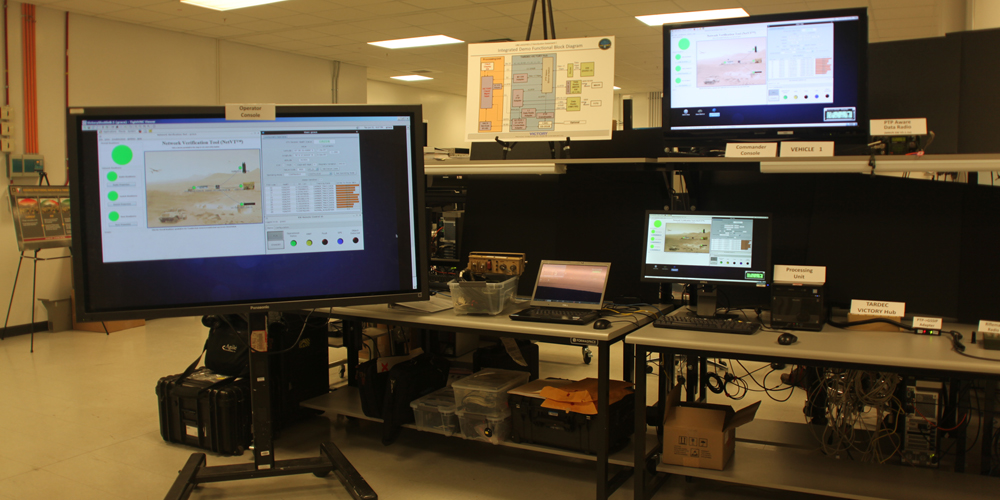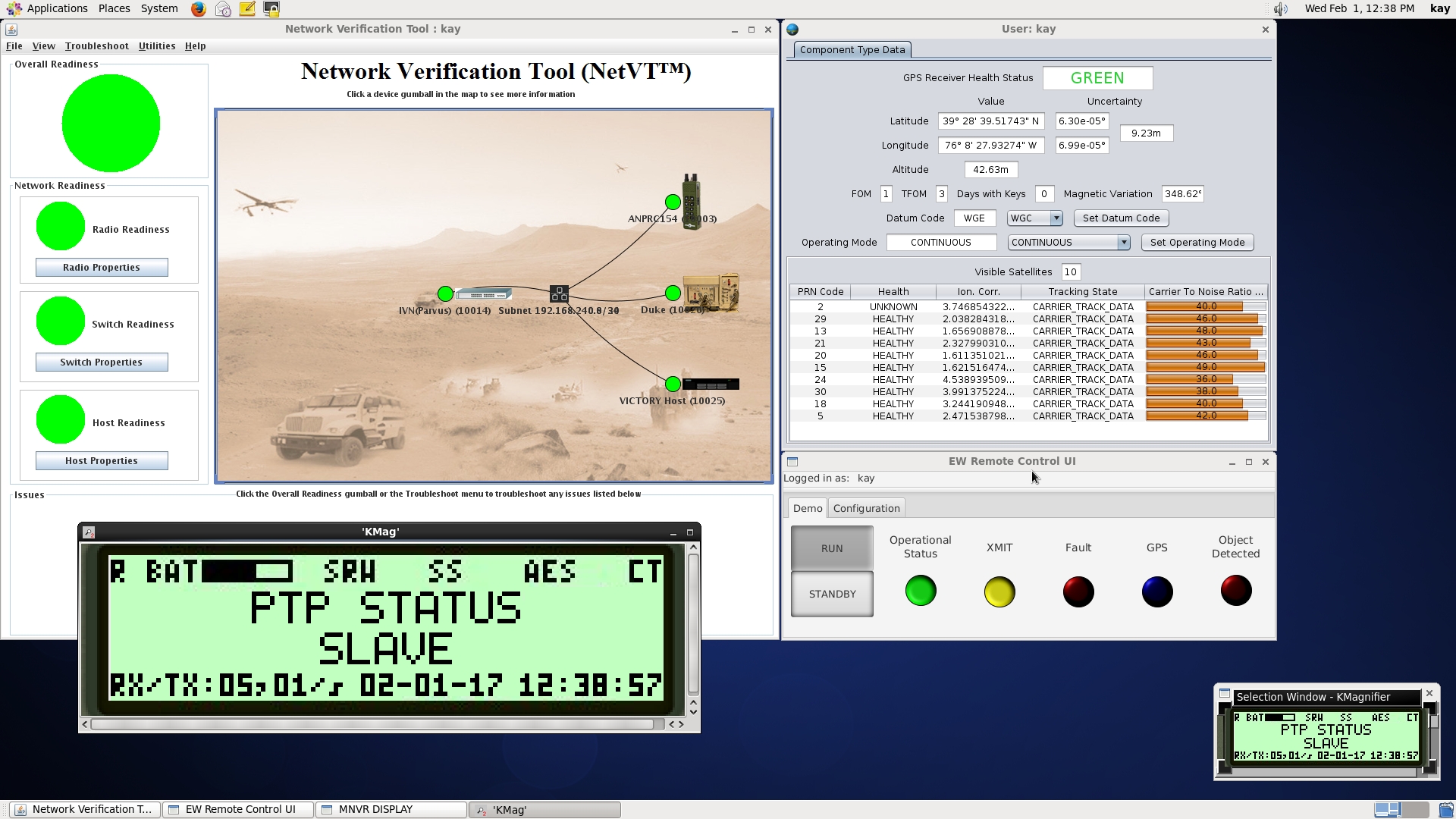
By Caitlin O’Neill, PM PNT staff writer
ABERDEEN PROVING GROUND, Md. — Working together towards a common vision, Army partners recently came together to collaborate on critical Army positioning, navigation and timing (PNT) initiatives, technologies and capabilities necessary to support integrated system development.
The Vehicular Integration for C4ISR/EW Interoperability (VICTORY) Standards Support Office (VSSO) risk reduction demonstration, held in January at Aberdeen Proving Ground, Md., focused on completing risk reduction efforts associated with implementing VICTORY capable systems on ground vehicle platforms.
The VSSO successfully demonstrated three major capability areas: Remote control and management of devices including PNT/GPS, data radios, and electronic warfare (EW); distributed position and timing via native implementation on tactical radio and via adapter functionality for legacy radios; and Information Assurance (IA) — demonstrating centralized access control capability using VICTORY compliant software.
The demonstration focused on distributed position and timing, remote control, and centralized access control using VICTORY capabilities on essential items found in a vast majority of Army vehicles such as GPS, tactical radios and EW devices. Charged with augmenting and enhancing Global Positioning Systems (GPS) to provide more reliable PNT for the Army, the Direct Reporting Program Manager Positioning, Navigation & Timing (PM PNT) protects the Soldier, and the equipment they use in the battlefield, through the development and fielding of advanced PNT technologies. As part of their strategy, PM PNT works closely with a number of partners across the Army and Department of Defense to ensure the most accurate and trusted PNT available to the Soldier.
The VSSO risk reduction demonstration involved partners from across the Army, including Program Executive Office (PEO) Ground Combat Systems (GCS), PEO Combat Support & Combat Service Support (CS&CSS), PEO Command Control Communications — Tactical (C3T), PEO Intelligence, Electronic Warfare & Sensors (IEW&S), Tank and Automotive Research, Development and Engineering Center (TARDEC) Vehicle Electronics and Architecture (VEA) and the Communications-Electronics Research, Development and Engineering Center (CERDEC) Command Power and Integration (CP&I) PNT Division.
“Building optimal PNT capabilities for the Soldier is no easy task.” Said Mr. Coggins, Program Manager for PM PNT. “Our partnerships play a critical role in making the Army PNT strategy a success and drive continuous innovation to provide the Warfighter with PNT data that they can trust.”

Computer analysis illustrates the successful distribution of time data to PEO C3T radios using a PNT distribution device. (Photo Credit: U.S. Army photo by Grace (Qi Ping) Xiang, PEO GCS)
VICTORY is a set of open standard specifications that promotes interoperability between Command, Control, Communications, Computers, Intelligence, Surveillance and Reconnaissance (C4ISR) and EW systems through the use of standardized on-the-wire messaging and interfaces. This systems engineering approach reduces the overall integration time and cost, allows resources and data to be shared, reduces the size, weight and power (SWaP) demand and total lifecycle cost and management complexity for the ground vehicle platforms. A benefit of VICTORY is the use of common software pieces, which can be implemented and reused by developers as they adopt VICTORY in their own systems.
Today, C4ISR/EW systems are integrated on ground vehicle platforms primarily utilizing serial connections (i.e., point-to-point), which are complicated. Modification to one system usually requires modifications to all other systems that are integrated with it. In addition, each system brings their own unique hardware resources, and in most cases, duplicate GPS receiver, monitor, keyboards, and antennas/cables associated with it. Data are not generally shared effectively among these stove-piped bolt-on systems.
Coupling VICTORY standards and concepts enables improved interoperability, flexibility and consolidation. “VICTORY has been a collaborative effort for years among many PEOs, including PEO C3T” said Mary Woods, Deputy PEO for C3T. “Platform integration is a major challenge for the Army, and VICTORY should help enable us to mitigate that challenge in the future.”
VICTORY has adopted the commercial standard Precision Time Protocol (PTP) version 2 (v2) as one of the VICTORY standards. As a widely accepted commercial standard there are many off-the-shelf hardware and software implementations available for reuse, thus negating the need for custom, proprietary timing solutions. The goal of the risk reduction demonstration was to share common data within a vehicle in an easier, more flexible and adaptable form using VICTORY compliant mechanisms.
Software defined tactical radios are critical to Soldiers working in highly challenging environments. Tactical communications provide Soldiers the capability to exchange voice, data and video even when spread over large geographic areas. Accurate timing is required for radios to synchronize and form tactical communication networks quickly. In collaboration with the CERDEC CP&I PNT lab, one capability the VSSO demonstrated was distributing time from a single PNT source simultaneously to two different types of tactical radios, establishing a continued connection and the Soldiers’ ability to communicate with one another.
Another focus of the demonstration was remote control and monitoring of C4 and EW devices. Remote control using standard VICTORY messaging enables Army vehicle operators to monitor and configure their onboard systems from a single, common display rather than having to reach for or access each device individually. VICTORY enabled device control also enables the Army vehicle community to consider relocating devices within the vehicle to reduce cab clutter and enhance safety through improved egress while still providing ready operator access.
The remote operation was focused on common operator tasks such as changing volume and presets on tactical radios, monitoring status of onboard GPS systems and monitoring and controlling the status of a Counter Remote Controlled Improvised Explosive Device (RCIED) Electronic Warfare (CREW) device (Duke v3).

A vehicle simulation is set up within the CERDEC CP&I lab to demonstrate the success of VICTORY standards in sharing time data to PEO C3T radios via a PNT distribution device. (Photo Credit: U.S. Army photo by Nancy JonesBonbrest, Army Rapid Capabilities Office)
The final focus of the demonstration was a centralized access control function using the VICTORY Access Control Software (VACS). Access to the radio and GPS configuration was controlled by VACS using authentication and authorization functions. Soldier or machine-to-machine actions were first authenticated and then checked for authorization. Both a valid and an invalid authorization scenario were demonstrated. This demonstration successfully established centralized access control functionality, which can be integrated into a larger, overall security strategy and architecture. As with other capabilities demonstrated, the VACS software is available for reuse.
The VICTORY risk reduction demonstration proved that a PTP switch has the ability to successfully send data to a number of systems on the network at once. Thorough testing was conducted confirming that providing PNT as a shared service would not degrade subscriber system capability. As a result, the Army has a clear path to access easier system interoperability and integration and accomplish SWaP reduction across vehicle platforms.
For more information on PM PNT, its programs and partnerships please visit www.pmpnt.army.mil.
This article was originally published on Army.mil.
Subscribe to Army AL&T News, the premier online news source for the Acquisition, Logistics, and Technology (AL&T) Workforce.







